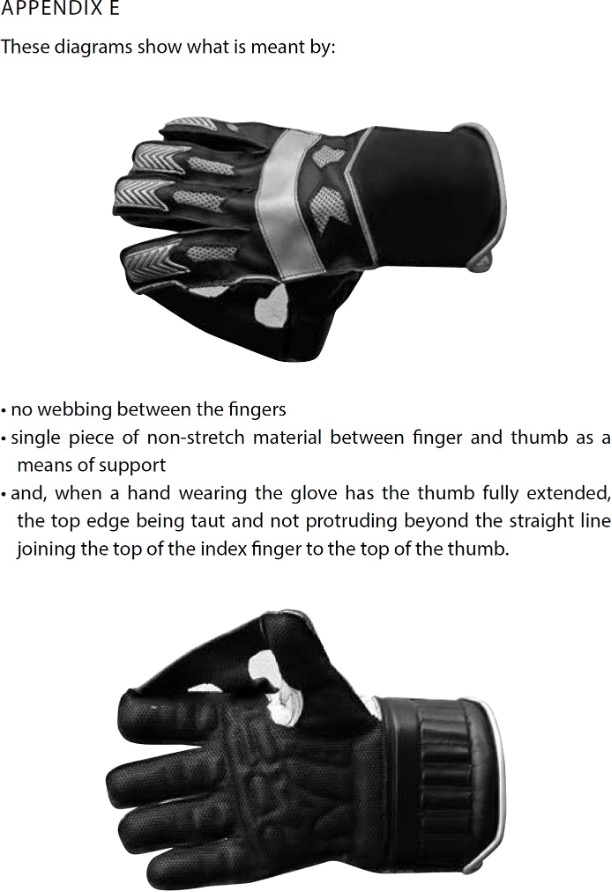Definitions and explanations of words or phrases not defined in the text of the Laws of Cricket.
A.1 The match
A.1.1 The game is used in these Laws as a general term meaning the Game of Cricket.
A.1.2 A match is a single encounter (or contest) between two sides (or teams), played under the Laws of Cricket.
A.1.3 The toss is the toss for choice of innings.
A.1.4 Before the toss is at any time before the toss on the day the match is expected to start or, in the case of a one-day match, on the day the match is due to take place.
A.1.5 Before the match is at any time before the toss, not restricted to the day on which the toss is to take place.
A.1.6 During the match is at any time after the toss until the conclusion of the match, whether play is in progress or not.
A.1.7 Playing time is any time between the call of Play and the call of Time. See Laws 12.1 (Call of Play) and 12.2 (Call of Time).
A.1.8 Conduct of the match includes any action relevant to the match at any time on any day of the match.
A.2 Implements and equipment
A.2.1 Implements used in the match are the bat, the ball, the stumps and bails.
A.2.2 External protective equipment is any visible item of apparel worn for protection against external blows.
For a batter, items permitted are a protective helmet, external leg guards (batting pads), batting gloves and, if visible, forearm guards.
For a fielder, only a protective helmet is permitted, except in the case of a wicket-keeper, for whom wicket-keeping pads and gloves are also permitted.
A.2.3 A protective helmet is headwear made of hard material and designed to protect the head, neck and/or the face. For the purposes of interpreting these Laws of Cricket, such a description will include faceguards, grilles and neck guards.
A.2.4 Equipment – a batter’s equipment is his/her bat as defined above, together with any external protective equipment he/she is wearing.
A fielder’s equipment is any external protective equipment that he/she is wearing.
A.2.5 The bat – the following are to be considered as part of the bat:
- the whole of the bat itself.
- the whole of a glove (or gloves) worn on the hand (or hands) holding the bat.
- the hand (or hands) holding the bat, if the batter is not wearing a glove on that hand or on those hands.
A.2.6 Held in batter’s hand - contact between a batter’s hand, or glove worn on his/her hand, and any part of the bat shall constitute the bat being held in that hand.
A.3 The playing area
A.3.1 The field of play is the area contained within the boundary.
A.3.2 The square is a specially prepared area of the field of play within which the match pitch is situated.
A.3.3 The outfield is that part of the field of play between the square and the boundary.
A.4 Positioning
A.4.1 Behind the popping crease at one end of the pitch is that area of the field of play, including any other marking, objects and persons therein, that is on that side of the popping crease that does not include the creases at the opposite end of the pitch. Behind, in relation to any other marking, object or person, follows the same principle. See the diagram in A.13.
A.4.2 In front of the popping crease at one end of the pitch is that area of the field of play, including any other marking, objects and persons therein, that is on that side of the popping crease that includes the creases at the opposite end of the pitch. In front of, in relation to any other marking, object or person, follows the same principle. See the diagram in A.13.
A.4.3 The striker’s end is the place where the striker stands to receive a delivery from the bowler only insofar as it identifies, independently of where the striker may subsequently move, one end of the pitch.
A.4.4 The bowler’s end is the end from which the bowler delivers the ball. It is the other end of the pitch from the striker’s end and identifies that end of the pitch that is not the striker’s end as described in A.4.3.
A.4.5 The wicket-keeper’s end is the same as the striker’s end as described in A.4.3.
A.4.6 In front of the line of the striker’s wicket is in the area of the field of play in front of the imaginary line joining the fronts of the stumps at the striker’s end; this line to be considered extended in both directions to the boundary. See A.4.2.
A.4.7 Behind the wicket is in the area of the field of play behind the imaginary line joining the backs of the stumps at the appropriate end; this line to be considered extended in both directions to the boundary. See A.4.1.
A.4.8 Behind the wicket-keeper is behind the wicket at the striker’s end, as defined above, but in line with both sets of stumps and further from the stumps than the wicket-keeper.
A.4.9 Off side/on side – see diagram in A.13
A.4.10 Inside edge is the edge on the same side as the nearer wicket.
A.5 Umpires
A.5.1 Umpire – where the description the umpire is used on its own, it always means ‘the bowler’s end umpire’ though this full description is sometimes used for emphasis or clarity. Similarly the umpires always means both umpires. An umpire and umpires are generalised terms. Otherwise, a fuller description indicates which one of the umpires is specifically intended. Each umpire will be bowler’s end umpire and striker’s end umpire in alternate overs.
A.5.2 Bowler’s end umpire is the umpire who is standing at the bowler’s end (see A.4.4) for the current delivery.
A.5.3 Striker’s end umpire is the umpire who is standing at the striker’s end (see A.4.3), to one side of the pitch or the other, depending on his/her choice, for the current delivery.
A.5.4 Umpires together agree applies to decisions which the umpires are to make jointly, independently of the players.
A.6 Batters
A.6.1 Batting side is the side currently batting, whether or not play is in progress.
A.6.2 Member of the batting side is one of the players nominated by the captain of the batting side, or any authorised replacement for such nominated player.
A.6.3 The striker is the batter who receives the ball delivered by the bowler.
A.6.4 The non-striker is the batter whose ground is at the bowler’s end when the ball is delivered.
A.6.5 A batter’s ground – at each end of the pitch, the whole area of the field of play behind the popping crease is the ground at that end for a batter.
A.6.6 Original end is the end where a batter was when the ball came into play for that delivery.
A.6.7 Wicket he/she has left is the wicket at the end where a batter was at the start of the run in progress.
A.6.8 A batting position is the position and posture adopted by the striker to receive a ball delivered by the bowler. A normal batting position is one from which a striker could be reasonably expected to defend his/her wicket.
A.6.9 For the purposes of these Laws, waist height is defined as the point at which the top of the batter’s trousers would conventionally be when he/she is standing upright at the popping crease.
A.7 Fielders
A.7.1 Fielding side is the side currently fielding, whether or not play is in progress.
A.7.2 Member of the fielding side is one of the players nominated by the captain of the fielding side, or any authorised replacement or substitute for such nominated player.
A.7.3 Fielder is one of the 11 or fewer players who together represent the fielding side on the field of play. This definition includes not only both the bowler and the wicket-keeper but also nominated players who are legitimately on the field of play, together with players legitimately acting as substitutes for absent nominated players. It excludes any nominated player who is absent from the field of play, or who has been absent from the field of play and who has not yet obtained the umpire’s permission to return.
A player going briefly outside the boundary in the course of discharging his/her duties as a fielder is not absent from the field of play nor, for the purposes of Law 24.2 (Fielder absent or leaving the field of play), is he/she to be regarded as having left the field of play.
A.8 Substitutes, Replacements and Runners
A.8.1 A Substitute is a player who takes the place of a fielder on the field of play, but does not replace the player for whom he/she substitutes on that side’s list of nominated players. A substitute’s activities are limited to fielding.
A.8.2 A Replacement is a player who takes the place of a nominated player and who, thereby, becomes a nominated player. A replacement’s activities on the field of play are no more limited than those of any other nominated player.
A.8.3 A Runner is a nominated player who runs for another nominated player of his/her own side who is batting and is unable to run
A.9 Bowlers
A.9.1 Over the wicket/round the wicket – if, as the bowler runs up between the wicket and the return crease, the wicket is on the same side as his/her bowling arm, he/she is bowling over the wicket. If the return crease is on the same side as his/her bowling arm, he/she is bowling round the wicket.
A.9.2 Delivery swing is the motion of the bowler’s arm during which he/she normally releases the ball for a delivery.
A.9.3 Delivery stride is the stride during which the delivery swing is made, whether the ball is released or not. It starts when the bowler’s back foot lands for that stride and ends when the front foot lands in the same stride. The stride after the delivery stride is completed when the next foot lands, i.e. when the back foot of the delivery stride lands again.
A.10 The Ball
A.10.1 The ball is struck/strikes the ball unless specifically defined otherwise, mean ‘the ball is struck by the bat’/‘strikes the ball with the bat’.
A.10.2 Full-pitch describes a ball delivered by the bowler that reaches or passes the striker without having touched the ground. Sometimes described as non-pitching.
A.11 Runs
A.11.1 A run to be disallowed is one that in Law should not have been taken. It is not only to be cancelled but the batters are to be returned to their original ends.
A.11.2 A run not to be scored is one that is not illegal, but is not recognised as a properly executed run. It is not a run that has been made, so the question of cancellation does not arise. The loss of the run so attempted is not a disallowance and the batters will not be returned to their original ends on that account.
A.12 The Person
A.12.1 Person; A player’s person is his/her physical person (flesh and blood) together with any clothing or legitimate external protective equipment that he/she is wearing except, in the case of a batter, his/her bat.
A hand, whether gloved or not, that is not holding the bat is part of the batter’s person.
No item of clothing or equipment is part of the player’s person unless it is attached to him/her.
For a batter, a glove being held but not worn is part of his/her person.
For a fielder, an item of clothing or equipment he/she is holding in his/her hand or hands is not part of his/her person.
A.12.2 Clothing – anything that a player is wearing, including such items as spectacles or jewellery, that is not classed as external protective equipment is classed as clothing, even though he/she may be wearing some items of apparel, which are not visible, for protection. A bat being carried by a batter does not come within this definition of clothing.
A.12.3 Hand for batter or wicket-keeper shall include both the hand itself and the whole of a glove worn on the hand.
A.13 Off side/on side; in front of/behind the popping crease
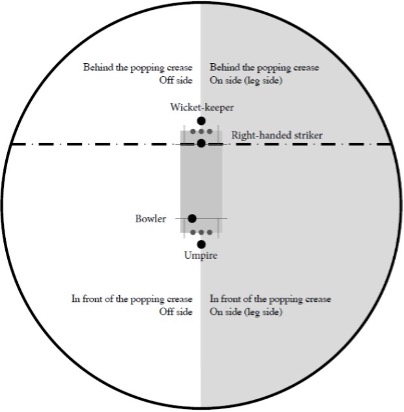
APPENDIX B: THE BAT (LAW 5)
B.1 GENERAL GUIDANCE
B.1.1 Measurements - all provisions in sections B.2 to B.6 below are subject to the measurements and restrictions stated in the Law and this Appendix.
B.1.2 Adhesives - throughout, adhesives are permitted only where essential and only in minimal quantity.
B.1.3 Categories of bat - the specifications given below relate to Type A, B C and D bats unless specified otherwise.
B.2 SPECIFICATIONS FOR THE HANDLE
B.2.1 One end of the handle is inserted into a recess in the blade as a means of joining the handle and the blade.
This lower portion is used purely for joining the blade and the handle together. It is not part of the blade but, solely in interpreting B.3 and B.4 below, references to the blade shall be considered to extend also to this lower portion of the handle where relevant.
B.2.2. The handle may be glued where necessary and bound with twine along the upper portion.
Providing Law 5.5 is not contravened, the upper portion may be covered with materials solely to provide a surface suitable for gripping. Such covering is an addition and is not part of the bat, except in relation to Law 5.6. The bottom of this grip should not extend below the point defined in B.2.4 below.
Twine binding and the covering grip may extend beyond the junction of the upper and lower portions of the handle, to cover part of the shoulders of the bat as defined in B.3.1.
No material may be placed on or inserted into the lower portion of the handle other than as permitted above together with the minimal adhesives or adhesive tape used solely for fixing these items, or for fixing the handle to the blade.
B.2.3. Materials in handle – As a proportion of the total volume of the handle, materials other than cane, wood or twine are restricted to one-tenth for Types A and B and one-fifth for Type C and Type D. Such materials must not project more than 3.25 in/8.26 cm into the lower portion of the handle
B.2.4. Binding and covering of handle – The permitted continuation beyond the junction of the upper and lower portions of the handle is restricted to a maximum, measured along the length of the handle, of
2.5 in/6.35 cm in for the twine binding
2.75 in/6.99 cm for the covering grip.
B.3 SPECIFICATIONS FOR THE BLADE
B.3.1. The blade has a face, a back, a toe, sides and shoulders
B.3.1.1 The face of the blade is its main striking surface and shall be flat or have a slight convex curve resulting from traditional pressing techniques. The back is the opposite surface.
B.3.1.2 The shoulders, sides and toe are the remaining surfaces, separating the face and the back.
B.3.1.3 The shoulders, one on each side of the handle, are along that portion of the blade between the first entry point of the handle and the point at which the blade first reaches its full width.
B.3.1.4 The toe is the surface opposite to the shoulders taken as a pair.
B.3.1.5 The sides, one each side of the blade, are along the rest of the blade, between the toe and the shoulders.
B.3.2 No material may be placed on or inserted into the blade other than as permitted in B.2.4, B.3.3, and Law 5.4 together with the minimal adhesives or adhesive tape used solely for fixing these items, or for fixing the handle to the blade.
B.3.3 Covering the blade - Type A and Type B bats shall have no covering on the blade except as permitted in Law 5.4. Type C and Type D bats may have a cloth covering on the blade. This may be treated as specified in B.4 below.
The cloth covering permitted for Type C and D bats shall be of thickness not exceeding 0.012 in/0.3 mm before treatment as in B.4.1.
Any materials referred to above, in Law 5.4 and B.4 below, are to be considered as part of the bat, which must still pass through the gauge as defined in B.8.
B.4 PROTECTION AND REPAIR
B.4.1. The surface of the blade may be treated with non-solid materials to improve resistance to moisture penetration and/or mask natural blemishes in the appearance of the wood. Save for the purpose of giving a homogeneous appearance by masking natural blemishes, such treatment shall not materially alter the colour of the blade.
B.4.2. Materials can be used for protection and repair as stated in Law 5.4 and are additional to the blade. Note however Law 5.6.
Any such material shall not extend over any part of the back of the blade except in the case of Law 5.4.1 and then only when it is applied as a continuous wrapping covering the damaged area.
The repair material shall not extend along the length of the blade more than 0.79 in/2.0 cm in each direction beyond the limits of the damaged area. Where used as a continuous binding, any overlapping shall not breach the maximum of 0.04 in/0.1 cm in total thickness.
The use of non-solid material which when dry forms a hard layer more than 0.004 in/0.01 cm in thickness is not permitted.
Additionally, for protection from damage, for Bat Types B, C and D, material may be inserted at the toe and/or along the sides, parallel to the face of the blade.
B.4.3. Permitted coverings, repair material and toe guards, not exceeding their specified thicknesses, may be additional to the dimensions above, but the bat must still pass through the gauge as described in B.8.
B.5. Toe and side inserts – the wood used must not be more than 0.35 in/0.89 cm in thickness.
The toe insert shall not extend from the toe more than 2.5 in/6.35 cm up the blade at any point.
Neither side insert may extend from the edge more than 1 in/2.54 cm across the blade at any point.
B.6 Commercial identifications - these identifications may not exceed 0.008 in/0.02 cm in thickness. On the back of the blade they must occupy no more than 50% of the surface. On the face of the blade, they must be confined within the top 9 in/22.86 cm, measured from where the bottom of the grip as defined in B.2.2 and B.2.4, would finish.
B.7 Type D Bats
Type D bats, as defined, shall comply with the size specifications and restrictions in Law 5 and this Appendix. The blade in addition may be
B.7.1 laminated but using only wood and with no more than three pieces.
B.7.2. coloured, providing Law 5.5 is not contravened.
B.8 Bat Gauge
All bats that conform to the Laws of Cricket must meet the specifications defined in Law 5.7. They must also, with or without protective coverings permitted in Law 5.4, be able to pass through a bat gauge, the dimensions and shape of which are shown in the diagram on the following page.
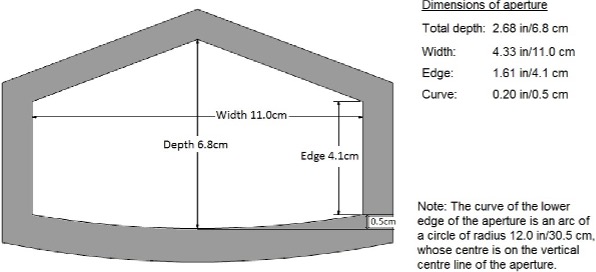
APPENDIX C: LAWS 6 (THE PITCH) AND 7 (THE CREASES)
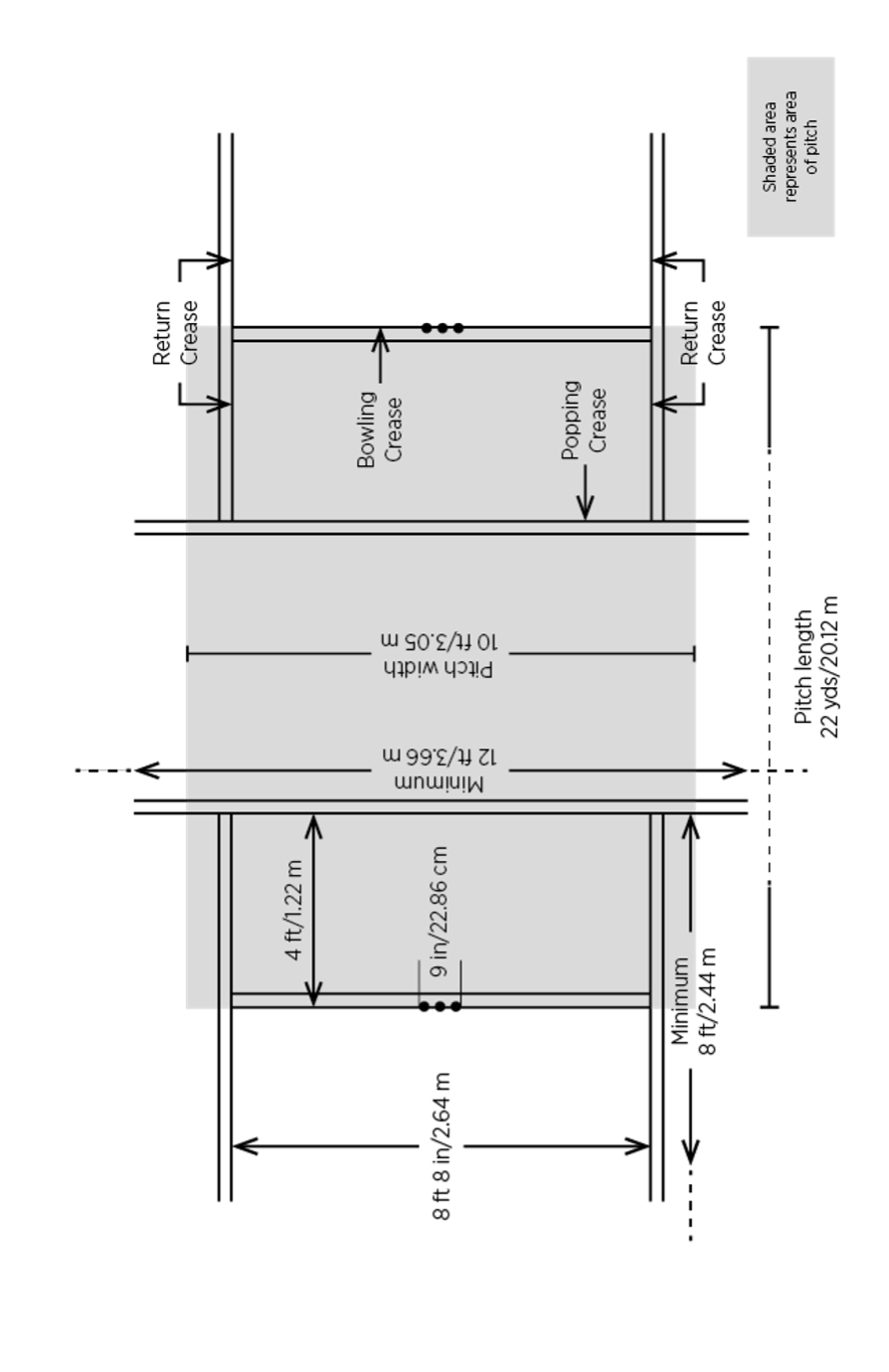
APPENDIX D - LAW 8 (THE WICKETS)
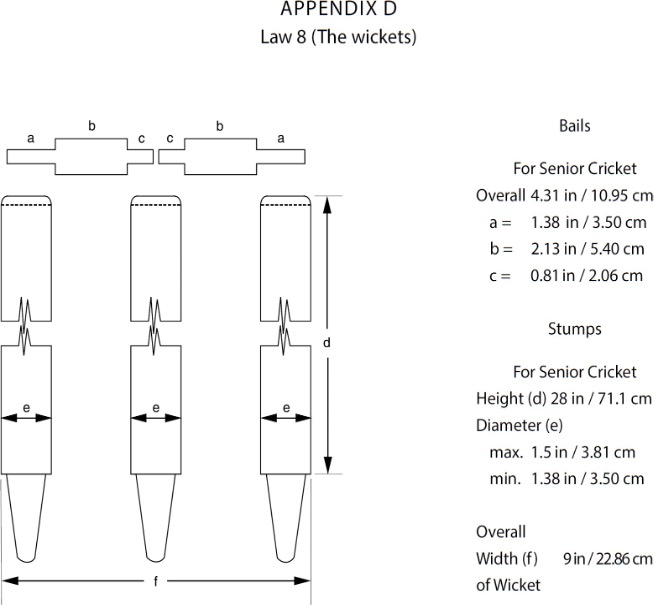
APPENDIX E
